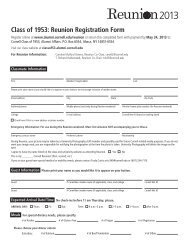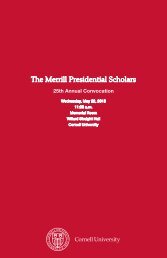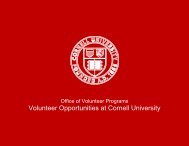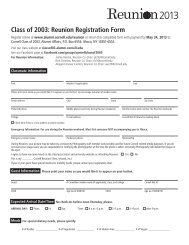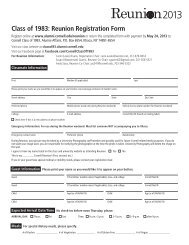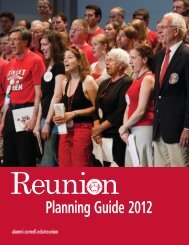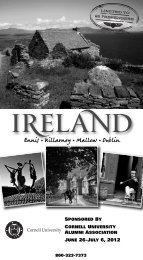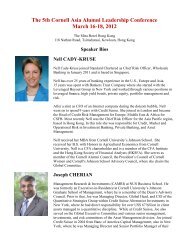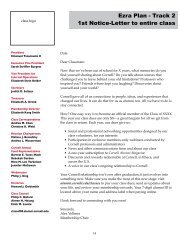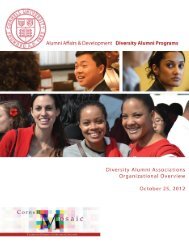Turning 20! - Alumni - Cornell University
Turning 20! - Alumni - Cornell University
Turning 20! - Alumni - Cornell University
You also want an ePaper? Increase the reach of your titles
YUMPU automatically turns print PDFs into web optimized ePapers that Google loves.
The inaugural meeting of the President’s Council of <strong>Cornell</strong><br />
Women, at Manhattan’s Hotel InterContinental on October 2,<br />
1990, was filled with excitement and anticipation, from the founding<br />
Steering Committee, waiting to learn how their planning would<br />
be received, to the new members invited by a summer letter from<br />
President Rhodes, who had little notion of what to expect. Reviewing<br />
that launch is one more reminder that clear objectives were set<br />
from the top, and little time lost in getting started. So that we have<br />
it preserved, here are excerpts from the opening act.<br />
When Chair Judy Monson introduced President Frank H.<br />
T. Rhodes, he inaugurated PCCW’s active status with his usual<br />
informality:<br />
“I leaned over a moment ago and said to Pat (Stewart), ‘This<br />
is a marvelous sight,’ and I must confess, in my 13 plus years<br />
at <strong>Cornell</strong>, I have not looked out across an audience that fills<br />
me with a greater sense of potent inspiration.. So welcome this<br />
morning, and thank you for the willingness you show, not<br />
Thriving on Regional Happenings<br />
PCCW formed an Alumnae Committee in 1992, then renamed<br />
it Alumnae and Student Relations with separate vice chairs in<br />
1997. In <strong>20</strong>00 Alumnae Affairs became a separate committee led<br />
by Marcia Epstein PCCW 1995, with a name change in <strong>20</strong>01 to<br />
Alumnae Relations. This marked the beginning of regional events<br />
to bring <strong>Cornell</strong> women together closer to where they live, which,<br />
over time, led to connecting with other alumnae who became<br />
PCCW members.<br />
In <strong>20</strong>02, PCCW’s annual schedule of two meetings a year was<br />
cut to one by the <strong>University</strong> to reduce the workload on <strong>Alumni</strong><br />
Affairs. This prompted the Steering Committee to consider<br />
alternatives, knowing that member meetings always sparked new<br />
connections, momentum and friendship, and many would miss<br />
their second option.<br />
In response, the Alumnae Relations Committee (now <strong>Alumni</strong><br />
Engagement), chaired by Randy Segal PCCW 1999 followed by<br />
Anita Miller PCCW 1994, decided that PCCW members should<br />
plan more regional gatherings that would enhance local <strong>Cornell</strong><br />
connections.<br />
Phyllis Weiss Haserot PCCW 1997, as regional liaison for New<br />
York City, took the lead in New York, organizing meetings with<br />
speakers who included Jane Brody, Sheryl Wu Dunn (both PCCW<br />
1990) and husband Nicholas Kristof, a program about developing<br />
musical shows, an architectural tour of Manhattan’s Upper East<br />
Side, interior design showcases, a <strong>Cornell</strong> architect’s space at the<br />
Brooklyn Museum to see “The Dinner Party,” and charitable events<br />
for business-attire recycler, the Bottomless Closet. Phyllis’s team<br />
also planned diversity events with such groups as the <strong>Cornell</strong> Black<br />
<strong>Alumni</strong> Association.<br />
Continuing this momentum, in <strong>20</strong>07 Diane Baker PCCW<br />
<strong>20</strong>02, and Micki Kuhs PCCW <strong>20</strong>05, planned an inspiring meeting<br />
11 MEMBERS<br />
Reconnecting Alumnae: Opening Curtain in 1990<br />
only to travel and join us today, but to join in this marvelous<br />
journey that we are about to embark on together. . . “<br />
President Rhodes continued: “Someone once said, ‘The audience is<br />
50 percent of any performance.’ In this case, the audience is 100 percent<br />
of the performance that is about to begin!” He then told new members:<br />
“The real secret of this gathering is the sense of unanimity that’s pervaded<br />
it from the beginning. That doesn’t happen automatically.” Moreover,<br />
he had “warmly endorsed” the plan to establish PCCW from the<br />
first time he heard it.<br />
“So what is it that we hope you can do together My answer is<br />
everything! But we hope specifically that you will concentrate on a<br />
number of points.” He cited four that were “wisely decided” on<br />
through the Steering Committee: Student Life; Women Faculty and<br />
Administration; Leadership, Career Counseling and Role Models,<br />
and “possibly providing Development Leadership for specifically<br />
women’s issues.”<br />
After members learned more about this PCCW game plan<br />
from Co-founder and Trustee Pat Carry Stewart and <strong>Cornell</strong><br />
administrators, and had lunch, Steering Committee chairs led their<br />
first meetings with new members. By 4:30, the group reassembled<br />
for the Chairs’ summary committee reports – and this long-running<br />
President’s Council performance was under way. With many<br />
variations, this scenario remains a familiar working model.<br />
“Ralph Bunch once said, ‘If you want to get across an idea<br />
of any sort, wrap it up in a person.’ And as I looked at the<br />
backgrounds of those of you here today, that’s exactly what<br />
we are doing…. The <strong>Cornell</strong> idea is embodied by those of you<br />
here today and the professional and personal success that you<br />
represent.”<br />
President Frank H.T. Rhodes’ closing to PCCW members,<br />
October 2, 1990, New York City<br />
in Chicago emphasizing the <strong>University</strong>’s goal of increased<br />
involvement by diverse alumnae featuring black and Hispanic law<br />
and business leaders.<br />
In Los Angeles, <strong>Alumni</strong> Relations Chair Nancy Mills PCCW<br />
1995 planned networking brunches featuring Jane Brody on<br />
healthy eating, and Dr. Gail Greendale ’76 discussing menopause;<br />
a talk on a “green environment,” that echoed a PCCW meeting<br />
on Sustainability; and luncheons followed by tours of the Getty<br />
and Los Angeles County Museums. Florida members have<br />
followed suit, while in Washington, DC, Randy Segal and Sandy<br />
Vogelsgang PCCW 1998, capitalized on members’ connections and<br />
the City’s resources to feature leaders in government and the arts.<br />
Building on a model of the first PCCW weekend in Miami in<br />
<strong>20</strong>03, in <strong>20</strong>04 Anita, a lawyer in Albuquerque, planned a special<br />
gathering for “orphan” PCCW members from communities with<br />
no regular PCCW: a “virtual” PCCW weekend in Santa Fe. Beyond<br />
tours of Santa Fe, Los Alamos and Bandelier National Monument,<br />
the highlight was our city girls’ visit with Linda Davis PCCW<br />
1999, at her cattle ranch in Cimarron, NM. In <strong>20</strong>06, Frankie<br />
Tutt, PCCW 1995, of Colorado Springs hosted another “virtual”<br />
PCCW gathering at the historic Broadmoor Hotel, long owned<br />
by her family. Members toured a “secret” defense facility, the Air<br />
Force Academy, a training facility for US Olympic teams and a<br />
magnificent state park.<br />
Diane Baker now chairs the <strong>Alumni</strong> Engagement Committee<br />
and under her leadership, PCCW groups in Philadelphia, Portland,<br />
Seattle, Upstate New York, Buffalo, Minneapolis, New Jersey and<br />
elsewhere are continuing to regionalize PCCW’s outreach.<br />
by Anita P. Miller PCCW 1994<br />
past Chair, Alumnae Relations Committee



